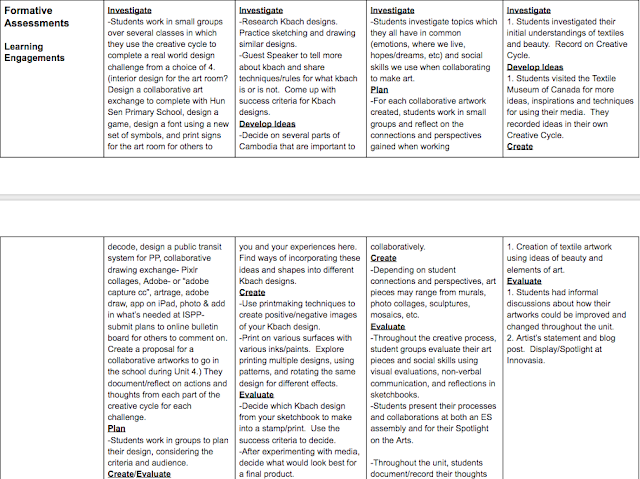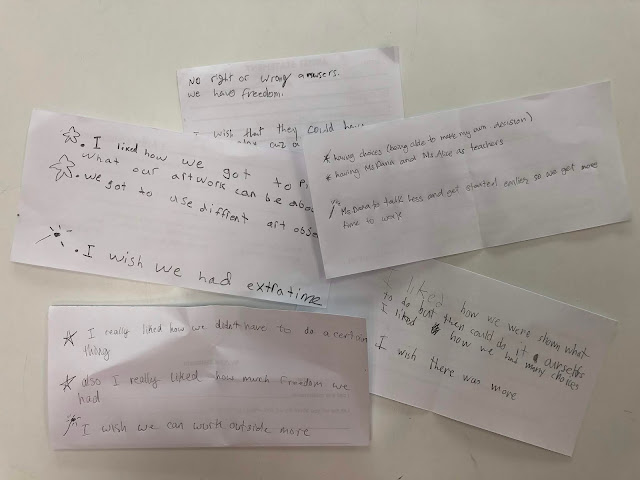Snapping Out of It: Making the Switch to a More Student-Centered Art Studio
Ever feel like you're in a funk? Like there's something not happening that should be? Not that anything is wrong, but just that something is...missing.
I had this lingering feeling last year about my teaching practice. I was teaching PYP visual arts at the International School of Phnom Penh (ISPP) and after 5 years of experience, getting to know the PYP, establishing a rapport with my students and colleagues, I had the premonition that it was time for a big change. Not in schools, not in what I was teaching, but in HOW I was teaching it. I realized that I was stressing out and spending my time planning Units of Inquiry that were lacking...something. That sometimes, despite my best efforts to allow for student choice and voice, the exhibitions of student pieces ended up lacking...something. That even when I had a super supportive admin team that appreciated both the process and product of art making, our curriculum was lacking...something. While that "something" was hard to define, in the back of my mind, I knew what needed to be done. I knew that I wanted to incorporate a more TAB-like, Studio Habits of Mind (SHoM) inspired approach to my practice. I needed to embody a more authentic system of student-centered inquiry. But I was afraid (and to be honest, a little lazy). It had become so easy to teach the way I had been. There were a lot of unknowns involved in turning my classroom upside down, using new routines and giving the students so much choice. Was it really worth all of that hassle?
So that drove me to taking action? What pushed me out of my teaching comfort zone? It happened during an amazing 1/2 day creativity workshop with Dinos Aristidou at ISPP. One of the many reflection strategies he had us participate in was an inner dialogue. He asked us to write down a problem or conflict we were currently experiencing and then personify it by writing out a conversation between ourselves and our problem. What would you say to it and what would it say back? I found myself writing up a storm. It was only 5 minutes but afterwards, I felt inspired. What WAS I waiting for? What was the worst that could happen? How could I be encouraging students to take risks in their practice when I wasn't willing to? It was settled. I was going to rewrite my yearly overview and adapt my approach to teaching art in order to make student voice and choice at the center of it all.
I spend the last weeks of the school year researching what others had done, following inspiring art educators on Twitter, and rewriting our arts program so that it continued to reflect the PYP as well as a more open-ended approach to creative problem-solving. The change was quite dramatic. I was surprised at how MUCH detail I had planned for in the past and how that obviously corresponded with the types of artworks students were producing. The new yearly overview fit on about 4 pages, whereas last years was over 30 pages! I took a page from our PE department's book and decided to teach the same units of inquiry to all grade levels at the same time, scaffolding and spiraling the skills and content at each grade level to challenge and help students grow. While this plan is bound to change as I teach, I am tremendously proud of what this year represents for both my students and myself.
My newest Yearly Overview:
Here are some screenshots from last year's overview for just ONE grade level. Imagine this multiplied by 5!
Starting this blog is a result of the above process. I hope it will be my platform for continuing to develop as an art educator. I'm looking forward to using this site as a place to share my journey, exchange ideas with others who have similar (or dissimilar) experiences, and gain insight into what's next!
I had this lingering feeling last year about my teaching practice. I was teaching PYP visual arts at the International School of Phnom Penh (ISPP) and after 5 years of experience, getting to know the PYP, establishing a rapport with my students and colleagues, I had the premonition that it was time for a big change. Not in schools, not in what I was teaching, but in HOW I was teaching it. I realized that I was stressing out and spending my time planning Units of Inquiry that were lacking...something. That sometimes, despite my best efforts to allow for student choice and voice, the exhibitions of student pieces ended up lacking...something. That even when I had a super supportive admin team that appreciated both the process and product of art making, our curriculum was lacking...something. While that "something" was hard to define, in the back of my mind, I knew what needed to be done. I knew that I wanted to incorporate a more TAB-like, Studio Habits of Mind (SHoM) inspired approach to my practice. I needed to embody a more authentic system of student-centered inquiry. But I was afraid (and to be honest, a little lazy). It had become so easy to teach the way I had been. There were a lot of unknowns involved in turning my classroom upside down, using new routines and giving the students so much choice. Was it really worth all of that hassle?
 |
| I was further left on this spectrum than I wanted or thought was beneficial for maximum student creativity and potential. image credit: www.theartofed.com |
So that drove me to taking action? What pushed me out of my teaching comfort zone? It happened during an amazing 1/2 day creativity workshop with Dinos Aristidou at ISPP. One of the many reflection strategies he had us participate in was an inner dialogue. He asked us to write down a problem or conflict we were currently experiencing and then personify it by writing out a conversation between ourselves and our problem. What would you say to it and what would it say back? I found myself writing up a storm. It was only 5 minutes but afterwards, I felt inspired. What WAS I waiting for? What was the worst that could happen? How could I be encouraging students to take risks in their practice when I wasn't willing to? It was settled. I was going to rewrite my yearly overview and adapt my approach to teaching art in order to make student voice and choice at the center of it all.
I spend the last weeks of the school year researching what others had done, following inspiring art educators on Twitter, and rewriting our arts program so that it continued to reflect the PYP as well as a more open-ended approach to creative problem-solving. The change was quite dramatic. I was surprised at how MUCH detail I had planned for in the past and how that obviously corresponded with the types of artworks students were producing. The new yearly overview fit on about 4 pages, whereas last years was over 30 pages! I took a page from our PE department's book and decided to teach the same units of inquiry to all grade levels at the same time, scaffolding and spiraling the skills and content at each grade level to challenge and help students grow. While this plan is bound to change as I teach, I am tremendously proud of what this year represents for both my students and myself.
My newest Yearly Overview:
Here are some screenshots from last year's overview for just ONE grade level. Imagine this multiplied by 5!
Starting this blog is a result of the above process. I hope it will be my platform for continuing to develop as an art educator. I'm looking forward to using this site as a place to share my journey, exchange ideas with others who have similar (or dissimilar) experiences, and gain insight into what's next!












Comments
Post a Comment